45个介词的基本用法
- 格式:ppt
- 大小:183.50 KB
- 文档页数:51

(1)表示时间的介词in的用法下。
表示在某一较长时间内,如世纪、年、月、季、周等一般用介词in,如:in the 1990s, in the year, in January, in(the) winter / summer / fall / spring, in the first week of May。
还可以用时段名词组成固定短语或词组。
如:in a while, in no time, in the daytime, in a short while, in time, in the morning (afternoon, evening)。
但要注意:①at night / at noon, in the day(在白天),in the night(大夜间)。
②in five days(weeks, months, years)中in意思是“在……以后”。
③in和during表一段时间内两词可互用。
如:in the night, during the night, in the war, during the war。
但略有区别:当接表示“活动”的抽象名词时多用during,接“活动”的动名词及短语时用in。
如:during the discussion in discussing the problemduring her stay in Hubei in playing basketballduring the course of in digging the tunnel(2)在具体的某一天或某天上午、晚上、前夕,常用on。
on Sunday(s).on Tuesday morningon Christmas Day(但at Chrismas),on Christmas Eve, onChildren’s Dayon March 8, on the morning (afternoon, evening)of Oct.1early on the morning of Oct.1(区别:in the late / early morning of Oct.1)on a rainy night, on warm winter days(3)表示某一时刻或某一点时间用at,如小时、分钟等。
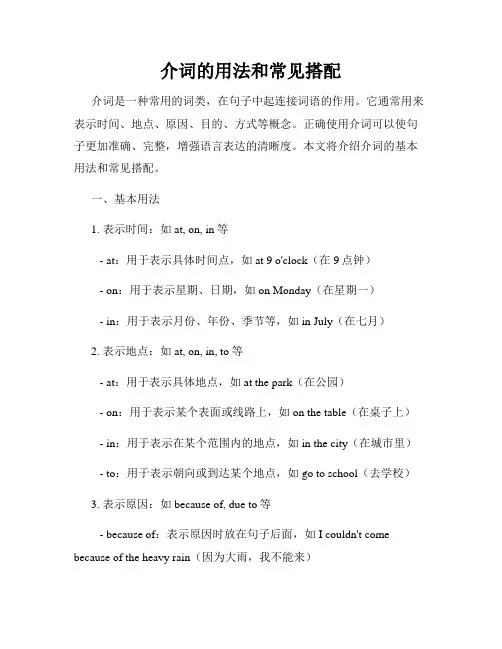
介词的用法和常见搭配介词是一种常用的词类,在句子中起连接词语的作用。
它通常用来表示时间、地点、原因、目的、方式等概念。
正确使用介词可以使句子更加准确、完整,增强语言表达的清晰度。
本文将介绍介词的基本用法和常见搭配。
一、基本用法1. 表示时间:如at, on, in等- at:用于表示具体时间点,如at 9 o'clock(在9点钟)- on:用于表示星期、日期,如on Monday(在星期一)- in:用于表示月份、年份、季节等,如in July(在七月)2. 表示地点:如at, on, in, to等- at:用于表示具体地点,如at the park(在公园)- on:用于表示某个表面或线路上,如on the table(在桌子上) - in:用于表示在某个范围内的地点,如in the city(在城市里) - to:用于表示朝向或到达某个地点,如go to school(去学校)3. 表示原因:如because of, due to等- because of:表示原因时放在句子后面,如I couldn't come because of the heavy rain(因为大雨,我不能来)- due to:表示原因时放在句子前面,如Due to the bad weather, the flight was delayed(由于天气不好,航班延误了)4. 表示目的:如for, to等- for:表示为了某个目的,如I bought a gift for my friend(我给朋友买了一份礼物)- to:表示某个动作的目的,如I went to the supermarket to buy some groceries(我去超市买了些杂货)5. 表示方式:如by, with等- by:表示某个动作的方式或手段,如travel by train(乘火车旅行) - with:表示某个工具或伴随的状态,如cut the cake with a knife(用刀子切蛋糕)二、常见搭配1. at:at home(在家)、at work(在工作)、at school(在学校)、at the airport(在机场)2. on:on the bus(在公交车上)、on the phone(打电话)、on the way(在路上)、on the Internet(在互联网上)3. in:in the morning(在早上)、in the evening(在晚上)、in the park(在公园)、in a hurry(匆忙地)4. to:go to bed(上床睡觉)、come to a decision(作出决定)、send a message to(发送消息给)5. for:for example(例如)、for sure(肯定)、for the first time(第一次)、for a long time(很久)6. by:by car(乘车)、by oneself(独自)、by accident(偶然地)、by hand(手工)7. with:play with friends(和朋友一起玩)、talk with teachers(和老师交谈)、help with homework(帮助做作业)三、总结介词是连接词语、起连接作用的重要词类。
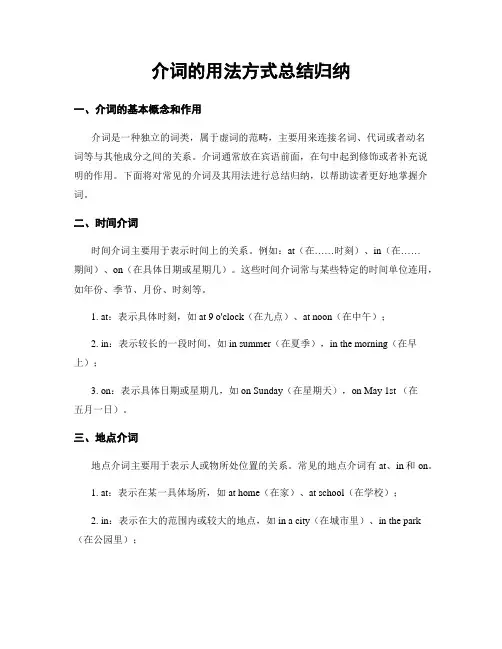
介词的用法方式总结归纳一、介词的基本概念和作用介词是一种独立的词类,属于虚词的范畴,主要用来连接名词、代词或者动名词等与其他成分之间的关系。
介词通常放在宾语前面,在句中起到修饰或者补充说明的作用。
下面将对常见的介词及其用法进行总结归纳,以帮助读者更好地掌握介词。
二、时间介词时间介词主要用于表示时间上的关系。
例如:at(在……时刻)、in(在……期间)、on(在具体日期或星期几)。
这些时间介词常与某些特定的时间单位连用,如年份、季节、月份、时刻等。
1. at:表示具体时刻,如at 9 o'clock(在九点)、at noon(在中午);2. in:表示较长的一段时间,如in summer(在夏季),in the morning(在早上);3. on:表示具体日期或星期几,如on Sunday(在星期天),on May 1st (在五月一日)。
三、地点介词地点介词主要用于表示人或物所处位置的关系。
常见的地点介词有at、in和on。
1. at:表示在某一具体场所,如at home(在家)、at school(在学校);2. in:表示在大的范围内或较大的地点,如in a city(在城市里)、in the park (在公园里);3. on:表示在物体表面或接触状态,如on the table(在桌子上)、on the wall (在墙上)。
四、方式介词方式介词主要用于表示行动或状态发生的方式。
常见的方式介词有by、with和in。
1. by:表示通过某种手段或方法,如by bus(乘坐公交车)、by phone(通过电话联系);2. with:表示使用某种工具或伴随着某个人或物,如write with a pen(用钢笔写字)、go shopping with friends (和朋友一起去购物);3. in:表示以某种方式进行,如send it in email (通过电子邮件发送)。
五、原因和目的介词原因和目的介词主要用于表示事物之间存在的原因关系或目的关系。
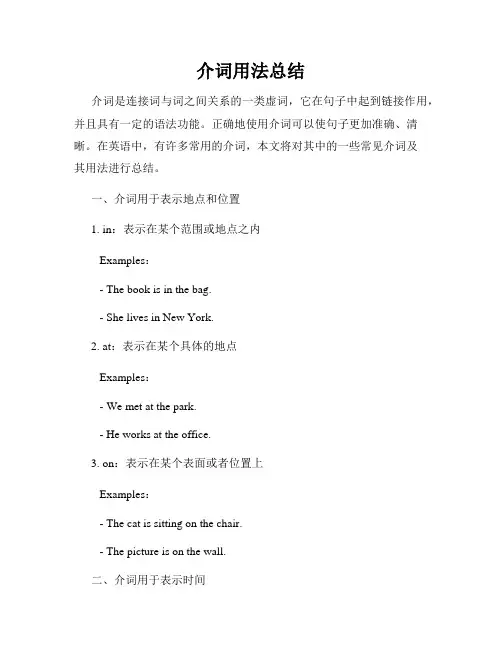
介词用法总结介词是连接词与词之间关系的一类虚词,它在句子中起到链接作用,并且具有一定的语法功能。
正确地使用介词可以使句子更加准确、清晰。
在英语中,有许多常用的介词,本文将对其中的一些常见介词及其用法进行总结。
一、介词用于表示地点和位置1. in:表示在某个范围或地点之内Examples:- The book is in the bag.- She lives in New York.2. at:表示在某个具体的地点Examples:- We met at the park.- He works at the office.3. on:表示在某个表面或者位置上Examples:- The cat is sitting on the chair.- The picture is on the wall.二、介词用于表示时间1. on:表示某一天或日期Examples:- I have a meeting on Monday.- We will celebrate New Year's Day on January 1st.2. at:表示具体的时刻Examples:- The train will arrive at 8 o'clock.- Let's meet at noon.3. in:表示较长的时间段Examples:- She will go on vacation in the summer.- We usually have a family dinner in the evening.三、介词用于表示原因和目的1. for:表示目的Examples:- I bought a new dress for the party.- He is studying hard for the exam.2. because of:表示因果关系- The match was canceled because of the rain.- She couldn't come to the party because of her illness.四、介词用于表示方式和手段1. by:表示通过某种方式或手段Examples:- I go to work by bus.- The letter was sent by email.2. with:表示使用某物或与某人一起Examples:- She wrote the letter with a pen.- He went to the park with his friends.五、介词用于表示关系和比较1. of:表示某物的一部分、属于或由...组成Examples:- The first chapter of the book is interesting.- The house is made of bricks.2. to:表示所属关系或比较- The tail belongs to the dog.- He is taller than his brother.六、其他常用介词1. with:表示同伴或陪伴关系Examples:- I went to the movies with my friends.- She enjoys traveling with her family.2. without:表示没有某种情况或物品Examples:- I can't live without music.- He ate lunch without a fork.总结:介词在英语中起到非常重要的作用,它可以连接词与词之间的关系,使句子更加准确和流畅。
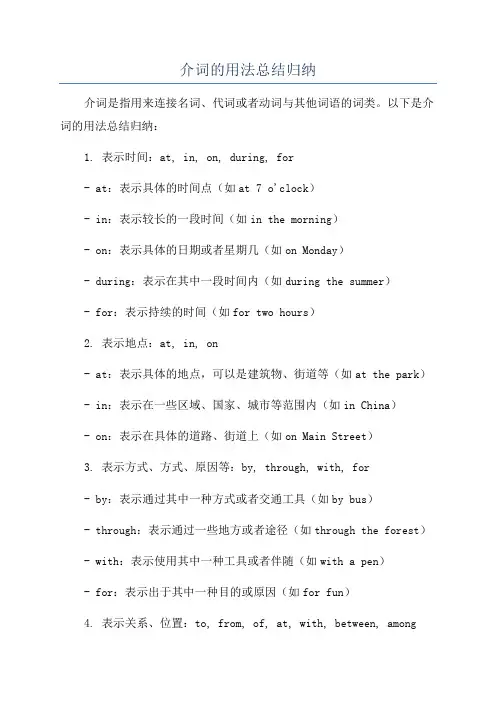
介词的用法总结归纳介词是指用来连接名词、代词或者动词与其他词语的词类。
以下是介词的用法总结归纳:1. 表示时间:at, in, on, during, for- at:表示具体的时间点(如at 7 o'clock)- in:表示较长的一段时间(如in the morning)- on:表示具体的日期或者星期几(如on Monday)- during:表示在其中一段时间内(如during the summer)- for:表示持续的时间(如for two hours)2. 表示地点:at, in, on- at:表示具体的地点,可以是建筑物、街道等(如at the park)- in:表示在一些区域、国家、城市等范围内(如in China)- on:表示在具体的道路、街道上(如on Main Street)3. 表示方式、方式、原因等:by, through, with, for- by:表示通过其中一种方式或者交通工具(如by bus)- through:表示通过一些地方或者途径(如through the forest)- with:表示使用其中一种工具或者伴随(如with a pen)- for:表示出于其中一种目的或原因(如for fun)4. 表示关系、位置:to, from, of, at, with, between, among- to:表示动作的目标、方向或者接触的人(如go to school)- of:表示所属关系或者材料(如a book of poetry)- at:表示一些地方或者特定位置(如look at the sky)- with:表示陪伴或者所带有的特征(如play with friends)- between:表示两者之间的关系(如between two buildings)- among:表示在多个元素中的关系(如among the flowers)5. 表示目的、目标:for, to, in order to- for:表示为了一些目的或者利益(如study for an exam)- to:表示动作的目标、方向或者接触的人(如go to a party)- in order to:表示为了达到一些目标或结果(如practice in order to improve)6. 表示比较、对比:than, as, like- than:表示比较两个事物的差异(如bigger than mine)- as:表示类似、与...一样(如the same as you)- like:表示类似、像...一样(如look like a cat)7. 其他常用介词:with, without, by, through, because of, on behalf of, in spite of, about, around- with:表示伴随、具备(如play with friends)- without:表示没有、无(如without any money)- by:表示通过、依靠(如by email)- through:表示穿过、通过(如walk through the door)- because of:表示因为(如cancel the trip because of the weather)- on behalf of:代表、代表着(如speak on behalf of the team)- in spite of:尽管(如in spite of the rain)- about:关于、大约(如talk about a movie)- around:在周围、大约(如walk around the lake)需要注意的是,介词的用法在不同的语境中可能存在细微的差异,因此需要根据具体的句子和语境来确定正确的介词使用。
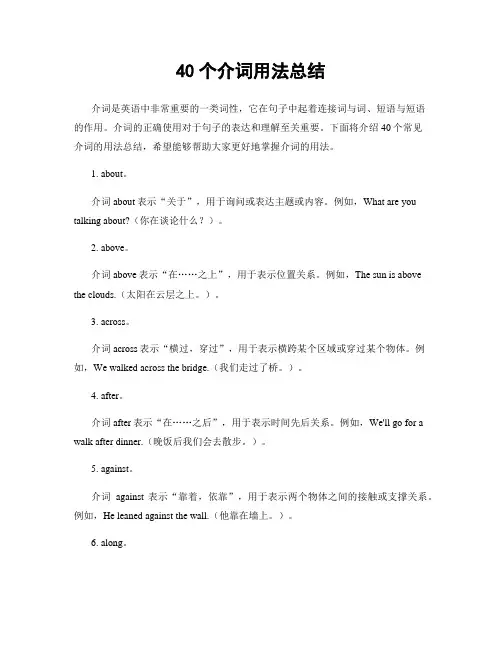
40个介词用法总结介词是英语中非常重要的一类词性,它在句子中起着连接词与词、短语与短语的作用。
介词的正确使用对于句子的表达和理解至关重要。
下面将介绍40个常见介词的用法总结,希望能够帮助大家更好地掌握介词的用法。
1. about。
介词about表示“关于”,用于询问或表达主题或内容。
例如,What are you talking about?(你在谈论什么?)。
2. above。
介词above表示“在……之上”,用于表示位置关系。
例如,The sun is above the clouds.(太阳在云层之上。
)。
3. across。
介词across表示“横过,穿过”,用于表示横跨某个区域或穿过某个物体。
例如,We walked across the bridge.(我们走过了桥。
)。
4. after。
介词after表示“在……之后”,用于表示时间先后关系。
例如,We'll go for a walk after dinner.(晚饭后我们会去散步。
)。
5. against。
介词against表示“靠着,依靠”,用于表示两个物体之间的接触或支撑关系。
例如,He leaned against the wall.(他靠在墙上。
)。
6. along。
介词along表示“沿着”,用于表示沿着某个方向或路线。
例如,We walked along the river.(我们沿着河边走。
)。
7. amid。
介词amid表示“在……之中”,用于表示某个场所或环境中。
例如,The children played happily amid the flowers.(孩子们在花丛中快乐地玩耍。
)。
8. among。
介词among表示“在……之中”,用于表示三个或三个以上的人或物之间的关系。
例如,She is among the top students in her class.(她是班里的尖子学生之一。
)。
9. around。

介词的用法与常见搭配介词是连接词与词之间关系的一种词类,在语法中占据重要的位置。
介词的正确使用可以帮助我们表达准确、流畅的语句。
本文将介绍介词的基本用法以及常见的搭配。
一、基本介词的用法介词通常用于连接名词、代词、动名词、动词短语等与其后面的词语之间的关系。
下面是介词的几种基本用法:1. 表示位置关系:- in(在):in the room(在房间里)- on(在……上):on the table(在桌子上)- at(在,位于):at the office(在办公室)- under(在……下面):under the chair(在椅子下面)- beside(在……旁边):beside the lake(在湖边)2. 表示方向关系:- to(到,向):go to school(去上学)- into(进入):jump into the pool(跳进游泳池)- through(通过):walk through the door(走过门口)3. 表示时间关系:- at(在某个具体时间):at 6 o'clock(在6点)- on(在某天或日期):on Sunday(在星期天)- in(在某个时间段内):in the morning(在早上)4. 表示原因关系:- because of(因为):He was late because of the traffic.(他因为交通堵塞而迟到。
)- due to(由于):The flight was delayed due to bad weather.(航班由于恶劣天气延误了。
)二、常见介词搭配介词的正确搭配可以帮助我们表达精确的意思。
以下是介词常见的搭配用法:1. be good at(擅长):She is good at playing the piano.(她擅长弹钢琴。
)2. look forward to(期待):I am looking forward to the summer vacation.(我期待着暑假。
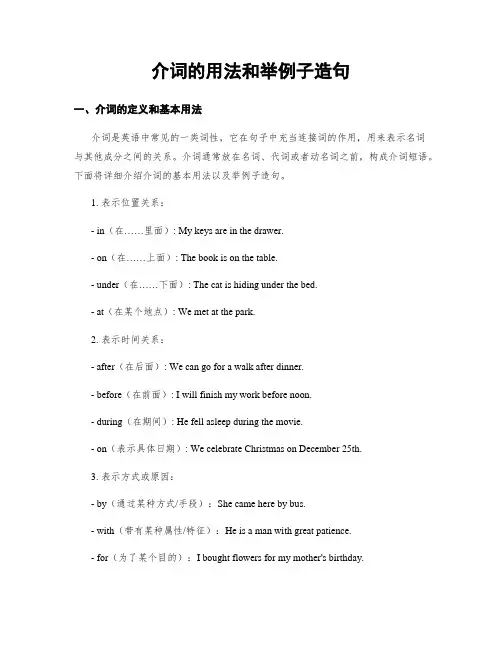
介词的用法和举例子造句一、介词的定义和基本用法介词是英语中常见的一类词性,它在句子中充当连接词的作用,用来表示名词与其他成分之间的关系。
介词通常放在名词、代词或者动名词之前,构成介词短语。
下面将详细介绍介词的基本用法以及举例子造句。
1. 表示位置关系:- in(在……里面): My keys are in the drawer.- on(在……上面): The book is on the table.- under(在……下面): The cat is hiding under the bed.- at(在某个地点): We met at the park.2. 表示时间关系:- after(在后面): We can go for a walk after dinner.- before(在前面): I will finish my work before noon.- during(在期间): He fell asleep during the movie.- on(表示具体日期): We celebrate Christmas on December 25th.3. 表示方式或原因:- by(通过某种方式/手段):She came here by bus.- with(带有某种属性/特征):He is a man with great patience.- for(为了某个目的):I bought flowers for my mother's birthday.4. 表示目的或结果:- for(给予目标对象,针对某人或某物): I bought a present for my sister.- to(到达某个地点): He went to the supermarket to buy groceries.- so as to(为了做某事): She studied hard so as to pass the exam.二、举例子造句1. 表示位置关系:- The cat is sitting in the box, enjoying its newfound hiding spot.- The painting on the wall adds a touch of color to the room.- She found her missing necklace under the pile of clothes on her bed.- I will meet you at the café near your office.2. 表示时间关系:- We can go for a walk after dinner when it's cooler outside.- Please submit your report before 5 p.m. tomorrow.- During our trip, we visited many famous landmarks in Europe.- Our anniversary falls on September 10th this year.3. 表示方式或原因:- He solved the problem by using a calculator.- She is an artist with a unique style of painting.- I bought sunscreen for protection against harmful UV rays.4. 表示目的或结果:- He brought flowers for his wife on their wedding anniversary.- They walked to school together every day, talking and laughing along the way.- She worked hard so as to achieve her dream of becoming a doctor.总结:介词是英语中常用的词性,用来表示名词与其他成分之间的关系。

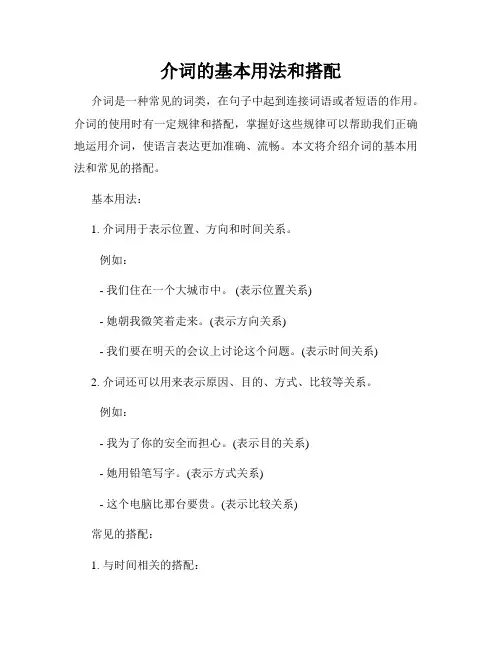
介词的基本用法和搭配介词是一种常见的词类,在句子中起到连接词语或者短语的作用。
介词的使用时有一定规律和搭配,掌握好这些规律可以帮助我们正确地运用介词,使语言表达更加准确、流畅。
本文将介绍介词的基本用法和常见的搭配。
基本用法:1. 介词用于表示位置、方向和时间关系。
例如:- 我们住在一个大城市中。
(表示位置关系)- 她朝我微笑着走来。
(表示方向关系)- 我们要在明天的会议上讨论这个问题。
(表示时间关系)2. 介词还可以用来表示原因、目的、方式、比较等关系。
例如:- 我为了你的安全而担心。
(表示目的关系)- 她用铅笔写字。
(表示方式关系)- 这个电脑比那台要贵。
(表示比较关系)常见的搭配:1. 与时间相关的搭配:- at:表示具体的时间点,如 at 7 o'clock(在7点钟);- on:表示具体的日期,如 on Monday(在星期一);- in:表示较长的时间段,如 in May(在五月)。
2. 与地点相关的搭配:- in:表示大的地区、国家或城市,如 in China(在中国);- on:表示具体位置的表面,如 on the table(在桌子上);- at:表示具体的地点,如 at the park(在公园里)。
3. 与方式相关的搭配:- by:表示通过某种方式实现,如 by train(乘坐火车);- with:表示使用某种工具或手段,如 with a pen(用钢笔);- in:表示以某种状态或方式,如 in silence(安静地)。
4. 与目的相关的搭配:- for:表示为了某个目的,如 for studying(为了学习);- to:表示向某个目标地方,如 to the library(去图书馆);- with:表示和某人或某物一起,如 with my friends(和我的朋友们一起)。
以上只是介词的基本用法和常见的搭配,实际使用中还有更多的情况和变化。
为了准确理解介词的使用,我们需要不断积累例句和实际语境的经验。

介词的基本用法介词是语法中的一种词类,用来表示名词、代词等与其他词之间的关系。
介词通常位于名词短语前面,起到连接词语的作用。
本文将详细介绍介词的基本用法。
1. 表示地点关系介词常用于表示物体或人的位置关系,可以简明地描述地点。
例如:in(在)、on(在…上面)、at(在…旁边)、under(在…下面)等。
示例:The book is on the table.(书在桌子上。
)2. 表示时间关系介词还可以用于表示时间关系,精确描述某个事件发生的时间或持续的时间。
常用的表示时间关系的介词有:at(在某个具体时刻)、on(在某天或某个具体日期)、in(在某个时间段内)等。
示例:I will meet him at 9 o'clock.(我将在9点钟见他。
)3. 表示原因关系有些介词可以表示原因、理由或出发点,常用的有:for(为了)、because of(因为)、due to(由于)等。
示例:He went to the park because of the nice weather.(他因为天气好去了公园。
)4. 表示方式和手段介词也可以表示某个行动或状态发生的方式或手段。
例如:by(凭借、通过)、with(用、带着)等。
示例:She draws a picture with a pencil.(她用铅笔画了一幅图画。
)5. 表示目的和结果有些介词可用于表示某个行动的目的或结果,如:to(表示目的)、for(表示目的)、result in(导致)等。
示例:I am going to the supermarket to buy some groceries.(我去超市买些日用品。
)6. 表示比较和对比介词还可以用于表示比较和对比关系。
例如:than(比)、as(和…一样)、like(像)等。
示例:She is taller than her sister.(她比她妹妹高。
)总结:介词在语法中起到连接词语的作用,表示名词、代词等与其他词之间的关系。
所有介词的用法和意思一、介词的基本概念介词是汉语中一类很重要的词性,它在句子中主要用来表示名词或代词与其他成分之间的关系。
介词通常置于名词前面,起到连接作用。
二、表示时间的介词1. in:表示具体日期、月份或年份。
例如:in May(五月),in 2021(2021年)。
2. on:表示星期几、具体日期。
例如:on Monday(星期一),on June 1st(六月一日)。
3. at:表示具体时刻、节日。
例如:at 8 o'clock(八点钟),at Christmas(圣诞节)。
三、表示地点的介词1. in:表示较大范围内的地点。
例如:in China(中国),in the park(公园内)。
2. on:表示表面上或某处特定位置。
例如:on the table(桌子上),on the left (在左边)。
3. at:表示具体位置或某处活动场所。
例如:at school(在学校),at the cinema(在电影院)。
四、表示方式的介词1. by:通过某种手段或方法实现。
例如:travel by train(乘火车旅行),learn by doing(通过做来学习)。
2. with:伴随或使用某物。
例如:go shopping with friends(与朋友一起去购物),write with a pen(用钢笔写)。
五、表示目的或原因的介词1. for:表示为了达到某个目标或出于某种原因。
例如:study hard for a better future(为了更好的未来而努力学习),I apologized for my mistake(因为我的错误我道歉)。
2. because of:因为某个原因。
例如:He couldn't come because of the bad weather(由于天气恶劣他不能来)。
六、表示方式的介词1. with:使用某种工具或方法来做某事。
介词的用法1.表示地点位置的介词1)at ,in, on, to,forat (1)表示在小地方; (2)表示“在……附近,旁边”in (1)表示在大地方; (2)表示“在…范围之内”。
on 表示毗邻,接壤,“在……上面”。
to 表示在……范围外,不强调是否接壤;或“到……”2)above, over, on 在……上above 指在……上方,不强调是否垂直,及 below相对;over指垂直的上方,及under相对,但over及物体有一定的空间,不直接接触。
on表示某物体上面并及之接触。
The bird is flying above my head. There is a bridge over the river. He put his watch on the desk.3)below, under 在……下面under表示在…正下方below表示在……下,不一定在正下方There is a cat under the table.Please write your name below the line.4)in front [frant]of, in the front of在……前面in front of…意思是“在……前面”,指甲物在乙物之前,两者互不包括;其反义词是behind(在……的后面)。
There are some flowers in front of the house.(房子前面有些花卉。
) in the front of 意思是“在…..的前部”,即甲物在乙物的内部.反义词是at the back of…(在……范围内的后部)。
There is a blackboard in the front of our classroom.我们的教室前边有一块黑板。
Our teacher stands in the front of the classroom.我们的老师站在教室前.(老师在教室里)5)beside,behindbeside 表示在……旁边behind 表示在……后面2.表示时间的介词1)in , on,at 在……时in表示较长时间,如世纪、朝代、时代、年、季节、月及一般(非特指)的早、中、晚等。
介词的基本用法及常见句型总结介词是英语中非常重要的一类词性,用来表示名词或代词与其他句子成分之间的关系。
在句子中,介词通常用于表示时间、地点、方向、原因、目的、手段等概念。
本文将总结介词的基本用法,并提供常见的句型示例。
一、表示时间1.介词"in"表示在某一特定时刻:- I will meet you in the morning.2.介词"on"表示在某一天、日期或特定的节日:- We will have a party on Christmas.3.介词"at"表示在某一具体时间(钟点):- The meeting will start at 9 o'clock.4.介词"by"表示在某一截止时间之前:- Please finish the report by Friday.5.介词"during"表示在某一时间段内:- I studied English during my summer vacation.6.介词"for"表示在一段时间内:- They have been friends for ten years.二、表示地点1.介词"in"表示在某一地点内:- She is waiting for you in the library.2.介词"on"表示在某一表面或平面上:- The book is on the table.3.介词"at"表示在某一具体地点:- Let's meet at the park tomorrow.4.介词"by"表示经过某一地点或靠近某一地点: - The bus will pass by the shopping mall.5.介词"to"表示朝向某一地点:- I am going to school.三、表示方向1.介词"from"表示从某一地点出发:- He came from the airport.2.介词"to"表示朝向某一地点:- She is walking to the supermarket.3.介词"into"表示进入某一地点:- The cat jumped into the box.4.介词"out of"表示从某一地点出来:- The children ran out of the classroom.四、表示原因1.介词"because of"表示因为某个原因:- He couldn't come to the meeting because of the traffic.2.介词"due to"表示由于某个原因:- The flight was delayed due to bad weather.3.介词"for"表示出于某种考虑或原因:- She chose the career path for personal development.五、表示目的1.介词"for"表示为了某种目的:- They went to the store for groceries.2.介词"to"表示到达某个目的地:- I am going to the park to meet my friends.六、表示手段1.介词"with"表示使用某种工具、手段:- I cut the cake with a knife.2.介词"by"表示通过某种手段实现:- She learned Chinese by watching Chinese movies.七、其他常见用法1.介词"of"用于表达分属关系、所属关系:- The cover of the book is torn.2.介词"about"用于表达关于某个主题的内容:- I know a lot about history.3.介词"with"用于表达伴随关系或某种属性:- She is a girl with curly hair.4.介词"by"用于表达被动方式或原因:- The book was written by a famous author.总结:介词的用法多种多样,常见的有表示时间、地点、方向、原因、目的、手段等。
介词的用法一.表示时间日期的介词1.at:主要表示方向、场所、时间的某一点at the corner of the street,at dinner,at sixty miles an hour,be sold at three yuan a dozen,come at us固定搭配:at one time,at the beginning of,at the post office,at the airport,at the weekend,at the age of 25,at the same time,at present,at any time,表示原因,表示“见/闻……而”。
at the newsat 主要表示时间点表示特定的时间at night a.m. 在九点钟表示不确定的时间at night, at that time, at Christmas在圣诞期间当天on表示年龄段at the age of eight 在8岁2.in:表示场所、时间与期限、状况、方向。
主要用来表示较长的时间单位,如月份、季节、年份等in the 1990s in the late 19th century形成“in+时段名词”的词组或固定搭配in those days,in the daytime,in a short while,in no time,in time.in 主要表示时间段一般指相对较长的时间段里in the morning, in spring, in the past ten years在…时间之后,用于将来时He will be back in a month.介词in在短语或句型中的省略:1) 某些形容词/过去分词后接v-ing形式时,v-ing形式前的介词in可以省略。
be busy (in) doing be engaged (in) doing (忙于……)2) 某些动词如busy等,常与反身代词连用,其后的in也可以省略。
介词的用法总结大全介词是连接名词、代词、动词或副词与其他部分的词类,用来表示位置、方向、时间、原因、目的、手段等关系。
以下是介词的用法总结:位置和方向:1. at:表示位置处于一些地点、其中一层次或其中一方向。
例如:at home(在家);at the top(在顶部)。
2. in:表示位置在一些区域、一些空间范围内。
例如:in the park (在公园里);in a box(在盒子里)。
3. on:表示位置在一些平面、表面上。
例如:on the table(在桌子上);on the wall(在墙上)。
时间:1. at:表示具体的时刻或一些时间点。
例如:at 9 o'clock(在九点钟);at noon(在中午)。
2. in:表示段时间的范围、一些季节、其中一年份或测算未来时间的过程。
例如:in May(在五月);in the 1990s(在20世纪90年代)。
3. on:表示一些具体的日期或星期几。
例如:on Monday(在星期一);on June 1st(在六月一日)。
原因和结果:2. due to:表示由于一些原因引起的结果,通常用于正式场合。
例如:The delay was due to technical problems(延误是由技术问题引起的)。
目的和目标:1. for:表示为了一些目的或目标。
例如:He studied hard for the exam(他为了考试而努力学习)。
2. to:表示向一些目的地或一些人传递信息等。
例如:I went to the supermarket to buy some groceries(我去超市买些杂货)。
手段和方法:1. with:表示使用其中一种工具、手段或方法。
例如:She cut the cake with a knife(她用刀切蛋糕)。
2. by:表示通过其中一种手段或方法。
例如:We traveled to the city by train(我们乘火车去了城市)。